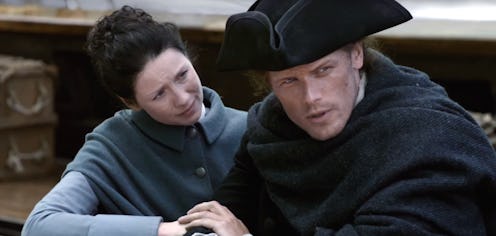Entertainment
‘Outlander’ Explores How Fear & Superstitions Held Women Back For Centuries

Claire has had to face sexism in the 20th century on Outlander especially, when it came to pursuing her career as a surgeon. But her return to the 1700s is a reminder that discrimination against women was expressed in other ways in the past. Spoilers for "The Doldrums" follow. Claire and Jamie sail to Jamaica, and, during their voyage, Claire learns of sexist sailor superstitions on Outlander. Similar to how she became known as La Dame Blanche, Claire is again experiencing firsthand the use of fear to ostracize women.
In the mid-20th century, it would have been rare for a man to say he was afraid of a woman taking his job. Yet, that insecurity and fear is part of what subconsciously drives prejudices. For example, Frank's boss at Harvard, Dean Jackson, stated in the Outlander Season 3 premiere that the women enrolled at Harvard Medical School were not competent enough to succeed in the medical field. He also implied that women belong in the home. This way of thinking was still prevalent when Claire eventually enrolled in medical school herself, based on the icy reception of her professor and the white male students.
Fear is regarded as a weakness, so someone as arrogant as Dean Jackson would never have considered that it was where his bias against women stemmed from. The 18th-century sailors on Claire and Jamie's boat actually believe their irrational fears are the truth, instead of understanding that their disdain for women on boats came from an insecurity about women being in their spaces in general. Other people besides Claire and Marsali (way to add drama by falling in love with Laoghaire's daughter, Fergus!) are targets on the boat — like Jamie because of his red hair and Mr. Willoughby because he's Chinese — but the superstitions about women are particularly preposterous, because the fear is a cover for how men desire women.
In an article that covers the superstitions against women on boats, Dive Training magazine wrote, "A more practical reason for the ban on women is that they would arouse passions and jealousy." And it's likely that the superstition stemmed from the resentment men had towards women for causing these feelings. To be clear, it's not the fault of women if men sexually desire them and act foolishly or violently because of that. Still, it's the women who are punished. And that punishment is justified by a concocted supernatural myth that women are back luck on ships. So, of course, Claire is exasperated as she attempts to dispel these outdated and harmful stereotypes, to no avail.
What the captain tells Claire is further proof that superstitions about women on boats are rooted in sexism is. He says that by rights, Claire and Marsali should be topless on the boat. He says bare-breasted women are said to calm angry seas and points to the exposed female figurehead on the bow of the ship as an example of this. And it's true that this was a real belief. The maritime consortium PortCities Southamption says, "Superstition amongst sailors said that the female figurehead should have eyes to find a way through the seas when lost, whilst her bare breast would shame a stormy sea into calm." PortCities also noted that this belief in the power of female nudity dates back to the ancient Roman scholar and navy commander Pliny the Elder nearly 2000 years ago, which helps explain why there are so many naked women on the fronts of ships in real life.
All of these myths about the magical abilities of women — particularly the bad ones — will end up playing a part later in Season 3. Spoilers for the book series follow. Claire and Jamie's search for Ian will lead them to Claire's fellow time traveler Geillis Duncan. In the book Voyager, Geillis uses her femininity to lure young men into having sex with her and then sacrifices them for her dark magic in Jamaica. Yet, exceptions like Geillis — a woman who literally practices witchcraft and murders with impunity — do not justify all of the superstitions that cast women in a negative light. So don't think for one second that Claire — who has been marked as a La Dame Blanche and been on trial for being a witch — is going to take kindly to seeing Geillis up to her old tricks. The 20th century-born Geillis continues to set back perceptions of women while Claire tries to actively improve them.
But while Geillis is a villain of the Outlander story, it's not fair to blame her for the way men treat women. As Claire has shown through her time traveling, it has always been an uphill battle for women to be viewed as men's equals. Whether it's because of illogical superstitions or academic prejudices, Claire has faced sexism throughout centuries. But as she continues to show how capable she is with her medical skills — after all, Captain Thomas Leonard of the British ship the Porpoise abducts her because of her knowledge — this time traveler can hopefully enlighten at least a few men along the way.